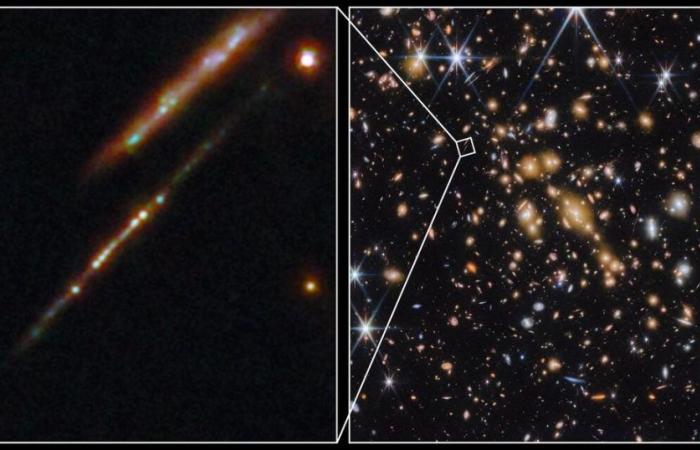Astronomers have observed star clusters in the Universe so dense that their mass and light played a key role in the evolution of their galaxy at the time of the cosmic dawn, according to a study published Monday in the Nature magazine.
The Cosmic Gems Arc depicts star clusters that were gravitationally bound when the Universe was only 460 million years old. This is the first discovery of star clusters in a nascent galaxy, less than 500 million years after the Big Bang.
External content
This external content cannot be displayed because it may collect personal data. To view this content you must authorize the category Social networks.
Accept Plus d’info
“It’s impressive, we don’t see anything like this in the contemporary local Universe,” Angela Adamo, professor at the astronomy department of Stockholm University, told AFP.
L’study which she signed with an international team identified five proto-globular clusters with remarkable characteristics, in a dwarf galaxy from the early ages of the Universe, 460 million years, therefore, after the Big Bang.
Discovered in 2018 in images The Cosmic Gems arc is the most distant ever observed, at more than 13.2 billion light years. It is in the midst of the so-called reionization period. (read box)when the intense activity of the first stars and galaxies will illuminate the Universe.
This cosmic dawn is one of the playgrounds of the new James Webb Space Telescope, which has an even sharper eye than Hubble’s, because it sees further into the infrared. Where the latter distinguished a faint arc of red light, the James Webb reveals “a very young galaxy, with very young star clusters inside,” according to Angela Adamo.
“This is really the first time that we can observe this type of object at this distance,” and therefore at such a distant time, notes Adélaïde Claeyssens, post-doctoral fellow in the astronomy department in Stockholm and co-signatory of the study.
This observation should help to understand the “formation of star clusters that we still observe in the nearby universe – which are now very old – and their influence on the formation of galaxies,” she adds.
A Universe very different from ours
“In our Milky Way we see about 170 globular clusters, but there were thousands of them,” before they were scattered or dislocated by the expansion of the galaxy, notes Angela Adamo. Above all, “the survivors inside the disk of the Milky Way do not weigh much, with a mass ‘insignificant’ compared to all the stars that populate it.”
While conversely, the five star clusters observed in Cosmic Gems Arc are real heavyweights, together representing around 30% of the galaxy’s mass: “This tells us that the Universe was very different”, at that time, according to the astronomer.
Very dense, these star clusters are each concentrated in a very small diameter, less than the four light years separating our Sun from its nearest star, Proxima Centauri: “Imagine that there are a million stars” in this space, Angela Adamo gives as an example.
With massive stars within them, whose mass would be 5,000 to 10,000 times that of the Sun, according to a recent study from the University of Geneva led by Professor Corinne Charbonnel.
>> About these colossal stars, read: Gigantic suns shone in ancient star clusters
For the latter, “the interest of this type of study is the gravitational lens (read box) which allows for great resolving power: thanks to it, distant globular clusters are visible,” she emphasizes to RTSinfo. Corinne Charbonnel – who did not participate in this study – is currently in a conference of astrophysics in the Dolomites that deals with this subject. GN-z11, the galaxy that the astrophysicist studied, does not benefit from a similar phenomenon that would have allowed determining more details in this object whose light is observed as it was 400 million years after the birth of the Universe.
“The distance at which these five large clusters are located suggests that they are globular proto-clusters: they are the progenitors of the globular clusters that we can observe in our galaxy, around 10 to 13 billion years ago “, she adds. “The further back in time we go towards the beginnings of the Universe, the more compact the galaxies are and the more massive the clusters.” And to emphasize that it will also be important to understand how the gravitational lens which acts as a magnifying glass is made: an element which will also say more about the objects magnified thanks to it.
The influence of star radiation
Angela Adamo recalls that “these massive stars produce a lot of radiation”, and that in this way, “they influence the way in which galaxies form stars and how the gas is distributed around the galaxies”. In the same way, these very massive stars, at the end of their short lives, created black holes, some of which could be the supermassive objects found today at the heart of many galaxies.
These observations open “a kind of window” on the genesis of galaxies, according to the astronomers of the study. To know more, it will be necessary to find other future globular clusters at the time of the cosmic dawn, and to be able to study them in more detail.
“The James Webb will help find some,” says Professor Adamo, but astronomers are also eagerly awaiting the arrival of the Extremely Large Telescope (ELT) of the European Southern Observatory “to help understand the physical processes at work in these galaxies”. “Another five years of waiting” before we better understand what was happening more than 13.2 billion years ago. “We will see galaxies measuring 300 light years,” rejoices Corinne Charbonnel. A very small distance on the scale of our vast Universe…
Stéphanie Jaquet and the afp






